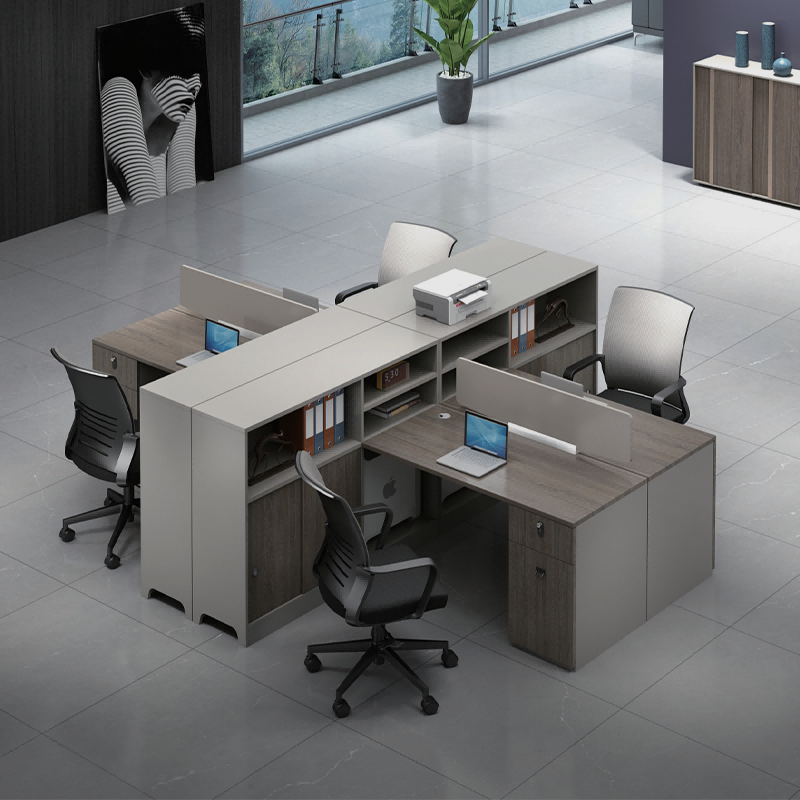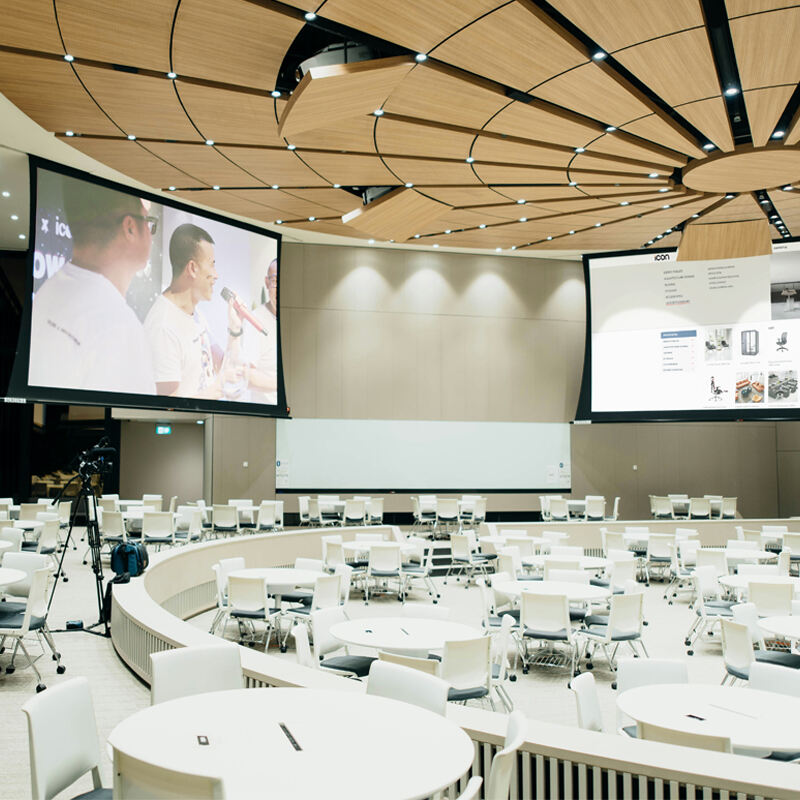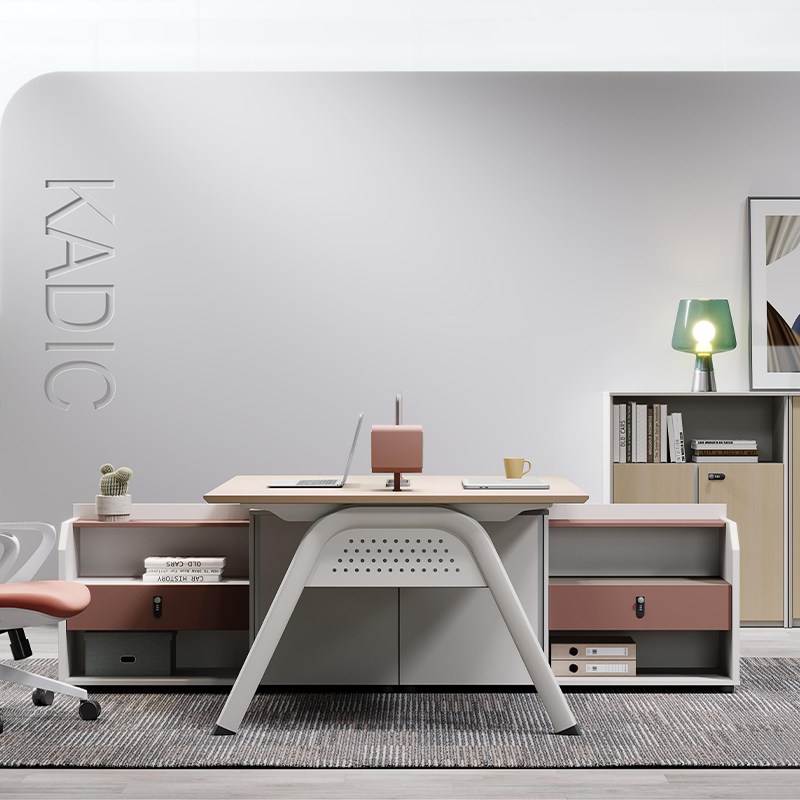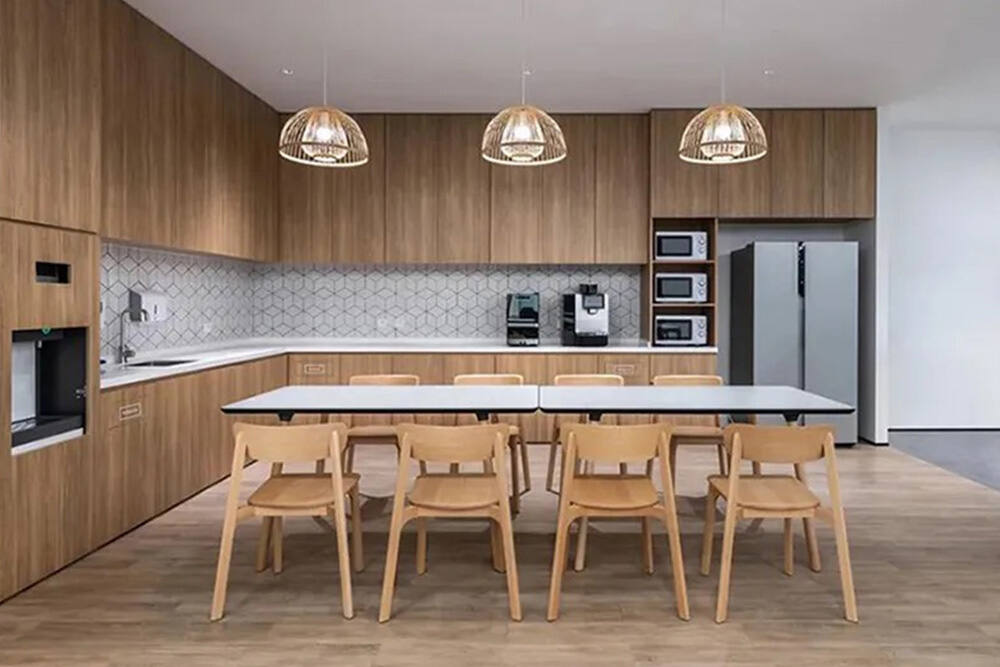Selección Muebles de oficina juega un papel crucial en la configuración de su espacio de trabajo. Los muebles duraderos garantizan un uso a largo plazo, ahorrándole de reemplazos frecuentes. Los diseños ergonómicos proporcionan comodidad y soporte, reduciendo el riesgo de lesiones en el lugar de trabajo y mejorando el bienestar de los empleados. Las piezas funcionales mejoran la productividad al satisfacer las necesidades específicas de sus tareas. Las elecciones reflexivas no solo crean un ambiente cómodo, sino que también contribuyen a la eficiencia de costos. Al invertir en muebles de calidad, construye un espacio de trabajo que apoya tanto a su equipo como a sus objetivos comerciales.
Evaluación del espacio y la disposición de las oficinas
Medir y planificar su espacio
Las medidas exactas forman la base de una oficina bien diseñada. Comience midiendo las dimensiones de su espacio de trabajo, incluyendo paredes, ventanas y puertas. Utilice estas medidas para crear un plano detallado. Este paso le ayuda a visualizar cómo encajarán los muebles y le asegura que no se aglomere.
Considere las necesidades específicas de su equipo. Identifique áreas para escritorios, salas de reuniones y espacios de colaboración. Asigne suficiente espacio para el movimiento y la comodidad. Un plan claro evita el desperdicio de espacio y asegura que cada esquina sirva a un propósito.
Utilice herramientas como planificadores de habitaciones en línea o papel gráfico para esbozar su diseño. Estas herramientas le permiten experimentar con diferentes arreglos antes de tomar decisiones finales. Planificar con anticipación ahorra tiempo y reduce los errores costosos.
Asegurar una disposición y flujo óptimos
Un diseño funcional mejora la productividad y crea un ambiente de trabajo agradable. Coloque los muebles para que el movimiento natural sea más fácil en toda la oficina. Evite colocar objetos grandes en los caminos o bloquear el acceso a áreas esenciales.
Piensa en cómo interactúan los empleados. Coloque escritorios y estaciones de trabajo para fomentar la colaboración manteniendo el espacio personal. Por ejemplo, los escritorios de grupo para proyectos de equipo, pero proporcionan zonas tranquilas para tareas enfocadas.
Incorpore principios ergonómicos en su diseño. Asegúrese de que las sillas y los escritorios estén a la altura y distancia adecuadas para reducir la tensión. Coloque los artículos que usa con frecuencia, como impresoras o archivos, a su alcance.
La iluminación también juega un papel clave en la planificación del diseño. Asegúrese de obtener la mayor cantidad de luz natural colocando los escritorios cerca de las ventanas. Utilice iluminación artificial para eliminar los rincones oscuros y crear un ambiente acogedor.
Al evaluar cuidadosamente su espacio y planificar su diseño, usted prepara el escenario para una oficina productiva y eficiente.
Priorizar la ergonomía
Características ergonómicas clave a las que debe fijarse
Al elegir muebles de oficina, debe centrarse en las características ergonómicas que promueven la comodidad y la salud. Empieza con sillas ajustables. Busque opciones con ajuste de altura, apoyo lumbar y respaldo reclinado. Estas características ayudan a mantener una postura adecuada y a reducir la tensión en la espalda.
Los escritorios también deben cumplir con normas ergonómicas. Elija escritorios con alturas ajustables para acomodar las posiciones sentadas y de pie. Esta flexibilidad le permite cambiar de posición durante todo el día, reduciendo la fatiga y mejorando la circulación.
Los reposabrazos y los reposapiés son otras características a tener en cuenta. Los reposabrazos deben sostener los brazos sin causar tensión en los hombros. Los apoyapiés proporcionan un apoyo adicional para las piernas, especialmente si los pies no tocan el suelo cuando se está sentado.
Los soportes de los monitores o los soportes ajustables son esenciales para el posicionamiento de la pantalla. Asegúrese de que su monitor esté a la altura de los ojos para evitar la tensión en el cuello. Las bandejas de teclado que permiten una posición de muñeca neutral también pueden mejorar la comodidad durante las tareas de mecanografía.
Ventajas de los muebles de oficina ergonómicos
Los muebles de oficina ergonómicos ofrecen importantes beneficios tanto para los empleados como para las empresas. Reduce el riesgo de lesiones en el trabajo, como dolor de espalda o lesiones por esfuerzo repetitivo. Al apoyar la postura correcta, reduce al mínimo la incomodidad durante largas horas de trabajo.
Los empleados cómodos tienden a ser más productivos. Cuando te sientes físicamente apoyado, puedes concentrarte mejor en las tareas. Esto conduce a una mayor eficiencia y a una mejor calidad del trabajo.
Invertir en muebles ergonómicos también demuestra el interés por el bienestar de los empleados. Un ambiente de trabajo que apoye aumenta la moral y la satisfacción en el trabajo. Los empleados felices son más propensos a quedarse con su empresa, lo que reduce las tasas de rotación.
El ahorro de costes a largo plazo es otra ventaja. Los muebles ergonómicos de alta calidad duran más y requieren menos reemplazos. Además, menos lesiones en el trabajo significan menores costes de atención médica y menos ausencias.
Al dar prioridad a la ergonomía al seleccionar muebles de oficina, se crea un espacio de trabajo más saludable y productivo. Esta inversión beneficia tanto a su equipo como a sus objetivos comerciales.
Elegir muebles de oficina con materiales duraderos
Materiales recomendados para la longevidad
Cuando se elige un mobiliario de oficina, los materiales que se eligen juegan un papel fundamental en determinar cuánto durará el mobiliario. Los materiales de alta calidad resisten el desgaste diario, asegurando que su inversión se rentabilice con el tiempo. Comience por considerar la madera maciza. Las opciones de madera dura como el roble, el arce o la cereza ofrecen una durabilidad excepcional y un aspecto atemporal. Estos materiales resisten los arañazos y las abolladuras, por lo que son ideales para escritorios, mesas y almacenes.
El metal es otra excelente opción para la longevidad. Los marcos de acero y aluminio proporcionan un soporte sólido para sillas, escritorios y estantes. Los acabados en polvo en las superficies metálicas añaden una capa adicional de protección contra el óxido y la corrosión, prolongando la vida útil de sus muebles.
Para sentarse, busque sillas con marcos reforzados y cojines de espuma de alta densidad. Las tapicerías hechas de cuero o tejidos de alto rendimiento resisten las manchas y el desvanecimiento. Los materiales sintéticos como el poliuretano o el vinilo también son duraderos y fáciles de limpiar, lo que los hace prácticos para áreas de alto tráfico.
El vidrio puede ser una opción elegante pero duradera para mesas o tabiques. El vidrio templado es más fuerte que el vidrio normal y tiene menos probabilidades de romperse. También resiste los arañazos, manteniendo su aspecto elegante con el tiempo.
Al elegir materiales conocidos por su resistencia y resistencia, se asegura que sus muebles de oficina permanezcan funcionales y visualmente atractivos durante años.
Ventajas de materiales de alta calidad
Invertir en materiales de alta calidad ofrece varias ventajas que van más allá de la durabilidad. En primer lugar, los materiales de primera calidad mejoran la apariencia general de su espacio de trabajo. Los escritorios de madera maciza o las sillas de cuero crean un aspecto profesional y pulido, dejando una impresión positiva en los clientes y visitantes.
Los materiales de alta calidad también mejoran la comodidad y la funcionalidad. Por ejemplo, las sillas ergonómicas con tapicería duradera proporcionan un apoyo constante, incluso después de un uso prolongado. Los escritorios robustos hechos de madera o metal mantienen su estabilidad, asegurando un espacio de trabajo confiable para los empleados.
El mantenimiento se hace más fácil con mejores materiales. Las superficies hechas de madera resistente a los arañazos o vidrio templado requieren menos mantenimiento, lo que ahorra tiempo y esfuerzo. Los tejidos y acabados resistentes a las manchas también ayudan a mantener su oficina limpia y profesional.
El ahorro de costes a largo plazo es otro beneficio clave. Aunque los materiales de alta calidad pueden tener un mayor costo inicial, reducen la necesidad de reemplazos frecuentes. Los muebles duraderos duran más tiempo, lo que reduce al mínimo las interrupciones y reduce los gastos generales.
Por último, el uso de materiales robustos favorece la sostenibilidad. Los muebles duraderos reducen el desperdicio y la necesidad de fabricación constante. Al seleccionar muebles de oficina hechos de materiales ecológicos o reciclables, usted contribuye a un lugar de trabajo más ecológico.
La elección de materiales de alta calidad garantiza que los muebles de oficina no solo duren sino que también mejoran la eficiencia y la estética de su espacio de trabajo.
Cuida bien el presupuesto de los muebles de oficina
Equilibrar costos y calidad
Al seleccionar muebles de oficina, es esencial encontrar el equilibrio adecuado entre el costo y la calidad. Los muebles de alta calidad suelen tener un precio más alto, pero proporcionan un valor a largo plazo. Los muebles baratos pueden ahorrar dinero al principio, pero a menudo se desgastan rápidamente, lo que lleva a reemplazos frecuentes y a mayores costos con el tiempo.
Comience por identificar sus prioridades. Enfoque en piezas que afectan directamente la comodidad y la productividad de los empleados, como sillas y escritorios ergonómicos. Estos elementos deben tener prioridad en su presupuesto porque contribuyen a un espacio de trabajo más saludable y eficiente.
Evalúe los materiales y la construcción de los muebles. Aunque la madera maciza, los marcos metálicos y los tapices duraderos pueden costar más por adelantado, duran más y mantienen su aspecto. Evite hacer descuentos en estos aspectos, ya que determinan la longevidad de su inversión.
Considere las garantías y las opiniones de los clientes al comparar las opciones. Una garantía fiable indica la confianza del fabricante en la durabilidad del producto. Las opiniones de otros compradores pueden proporcionar información sobre el rendimiento y el valor de los muebles.
Si se evalúa cuidadosamente el costo y la calidad, se pueden tomar decisiones informadas que maximizen el presupuesto y se asegure de que el mobiliario de la oficina satisfaga sus necesidades.
Explorando estrategias para ahorrar
No es necesario gastar demasiado para crear un espacio de trabajo funcional y atractivo. Hay varias estrategias de ahorro de costos que pueden ayudarle a mantenerse dentro del presupuesto sin comprometer la calidad.
Compre en grandes cantidades: Si compra varias piezas a la vez, a menudo puede obtener descuentos. Muchos proveedores ofrecen precios más bajos para pedidos a granel, especialmente para escritorios, sillas y unidades de almacenamiento.
Considere muebles usados: Muebles usados de alta calidad pueden ser una opción económica. Busque artículos usados con cuidado de vendedores de buena reputación o de empresas que están reduciendo sus cantidades. Antes de comprar, inspeccione los muebles para ver si están desgastados.
Compre durante las ventas: Aproveche las ventas de temporada o los eventos de despacho. Los minoristas suelen ofrecer importantes descuentos durante estos períodos, lo que le permite ahorrar en muebles de alta calidad.
Opte por muebles modulares: las piezas modulares son versátiles y pueden adaptarse a diferentes diseños. Invertir en muebles modulares reduce la necesidad de reemplazos cuando su oficina necesita cambios.
Negociar con los proveedores: no dude en negociar precios, especialmente para pedidos grandes. Muchos proveedores están dispuestos a ofrecer descuentos o envío gratuito para asegurar su negocio.
Priorizar los artículos esenciales: En primer lugar, enfoque su presupuesto en los muebles esenciales. Una vez que haya cubierto los elementos básicos, destine los fondos restantes para piezas adicionales o mejoras.
Al aplicar estas estrategias, puede ampliar aún más su presupuesto y al mismo tiempo seleccionar muebles de oficina que cumplan con sus estándares de durabilidad y funcionalidad.
Consideración de la funcionalidad y el almacenamiento
Muebles de uso múltiple y modular
La elección de muebles multiusos y modulares puede transformar su oficina en un espacio de trabajo más eficiente y adaptable. Este tipo de muebles tienen múltiples funciones, ahorrando espacio y reduciendo la necesidad de piezas adicionales. Por ejemplo, un escritorio con cajones de almacenamiento incorporados elimina la necesidad de archivos separados. Del mismo modo, un sofá cama en un salón puede servir como lugar de descanso para los empleados o como asiento para reuniones.
Los muebles modulares ofrecen flexibilidad. Puedes reorganizarlo o reconfigurarlo para adaptarlo a las necesidades cambiantes. Los escritorios modulares, por ejemplo, permiten crear estaciones de trabajo individuales o configuraciones colaborativas según los requisitos de su equipo. Esta adaptabilidad hace que los muebles modulares sean una excelente opción para empresas en crecimiento u oficinas con espacio limitado.
Busque muebles que se integren perfectamente en su diseño. Las piezas con líneas limpias y colores neutros se combinan bien con varios estilos de diseño. Además, prioricen los artículos que sean fáciles de ensamblar y desarmar. Esta característica simplifica la reubicación o reorganización, ahorrando tiempo y esfuerzo.
Invertir en muebles multiusos y modulares mejora la funcionalidad y maximiza el potencial de su oficina. Estas opciones versátiles aseguran que su espacio de trabajo siga siendo práctico y a prueba de futuro.
Soluciones de almacenamiento eficaces
Las soluciones de almacenamiento eficaces mantienen su oficina organizada y libre de desorden. Un espacio bien organizado mejora la productividad y crea un ambiente profesional. Comience por evaluar sus necesidades de almacenamiento. Identifique los tipos de artículos que necesita almacenar, como documentos, artículos de oficina o objetos personales.
Las opciones de almacenamiento vertical, como armarios altos o estanterías, aprovechan al máximo el espacio limitado. Estas soluciones proporcionan un amplio espacio de almacenamiento sin sobrepoblar su oficina. Los estantes o tableros fijos en la pared ofrecen un almacenamiento adicional mientras mantienen los artículos a su alcance.
Para artículos más pequeños, considere los organizadores de cajones o los contenedores de almacenamiento. Estas herramientas ayudan a clasificar y almacenar los suministros de manera ordenada. Etiquetar cada compartimiento o contenedor garantiza un acceso rápido y reduce el tiempo que se gasta buscando artículos.
Las unidades móviles de almacenamiento, como carros rodantes o archivos, añaden flexibilidad. Puedes moverlos por la oficina según sea necesario, lo que los hace ideales para espacios compartidos o instalaciones temporales. Las opciones de almacenamiento con cerradura proporcionan una seguridad adicional para documentos confidenciales o equipos valiosos.
Elige soluciones de almacenamiento que se adapten a la estética de tu oficina. Los diseños elegantes y modernos mantienen un aspecto cohesivo mientras sirven a un propósito funcional. Los materiales duraderos, como el metal o el laminado, aseguran que sus unidades de almacenamiento soporten el uso diario.
Al implementar soluciones de almacenamiento eficaces, se crea un espacio de trabajo ordenado y eficiente. Una oficina organizada fomenta la concentración y mejora la productividad general.
Planificación para el crecimiento futuro
Opciones de muebles flexibles y adaptables
La selección de muebles que se adapten al cambio asegura que su oficina siga siendo funcional a medida que su negocio evoluciona. Los muebles flexibles le permiten reconfigurar su espacio de trabajo sin necesidad de reemplazos. Esta adaptabilidad ahorra tiempo y dinero, mientras que mantiene su oficina eficiente.
Comience por considerar los muebles modulares. Los escritorios, mesas y unidades de almacenamiento modulares pueden reorganizarse para adaptarse a diferentes diseños. Por ejemplo, puede combinar escritorios modulares para crear estaciones de trabajo colaborativas o separarlas para tareas individuales. Esta versatilidad hace que los muebles modulares sean una opción inteligente para las empresas en crecimiento.
Busque elementos ajustables en sus muebles. Los escritorios y sillas ajustables en altura se adaptan a empleados de diferentes tamaños y preferencias. Estas opciones también respaldan las necesidades ergonómicas, promoviendo el confort y la productividad.
Los muebles plegables o apilables proporcionan una flexibilidad adicional. Las sillas y mesas que se pongan o apilaran se pueden guardar fácilmente cuando no se usan. Esta característica es especialmente útil para espacios polivalentes, como salas de conferencias o zonas de formación.
Elija muebles con materiales duraderos para asegurarse de que resistan ajustes frecuentes. Los materiales de alta calidad mantienen su aspecto y funcionalidad con el tiempo, incluso con reconfiguraciones regulares. Invertir en muebles adaptables prepara a su oficina para futuros cambios, manteniendo un ambiente profesional y organizado.
Prepararse para la expansión del equipo y las necesidades cambiantes
La planificación para el crecimiento del equipo implica la selección de muebles que acomoden a nuevos empleados y flujos de trabajo en evolución. Anticiparse a estos cambios le ayuda a evitar interrupciones y asegura una transición sin problemas a medida que su negocio se expande.
Comience por evaluar el diseño de su oficina actual. Identifique las áreas donde puede agregar estaciones de trabajo o espacios de colaboración. Deje espacio para escritorios, sillas y almacenes adicionales para evitar la superpoblación a medida que crece su equipo.
Considere espacios de trabajo compartidos o soluciones de escritorio de trabajo. Estas configuraciones permiten que varios empleados usen la misma estación de trabajo en diferentes momentos. Los espacios compartidos maximizan la eficiencia y reducen la necesidad de escritorios individuales, lo que los hace ideales para equipos en crecimiento.
Invierta en muebles que apoyen diversas tareas. Por ejemplo, elija escritorios con gestión de cables incorporados para funciones de alta tecnología o unidades de almacenamiento con estantes ajustables para diferentes necesidades. Los muebles versátiles aseguran que su oficina se adapte a diferentes funciones laborales.
Piense en las necesidades a largo plazo al seleccionar muebles. Optar por piezas que se combinen con el diseño de su oficina y se puedan integrar perfectamente en futuros diseños. Este enfoque minimiza la necesidad de reemplazos y mantiene un aspecto cohesivo.
Al prepararse para la expansión del equipo y las necesidades cambiantes, crea un espacio de trabajo que crece con su negocio. Una planificación cuidadosa asegura que su oficina siga siendo productiva, cómoda y lista para nuevas oportunidades.
Evitar errores comunes al elegir muebles de oficina
No se tiene en cuenta la ergonomía y la aportación de los empleados
Ignorar la ergonomía a menudo conduce a molestias y a una menor productividad en el lugar de trabajo. Al elegir muebles de oficina, debe dar prioridad a la salud y el bienestar de sus empleados. Las sillas y los escritorios ergonómicos ayudan a prevenir el dolor de espalda, la tensión en el cuello y otras lesiones comunes en el lugar de trabajo. Las características ajustables, como la altura del asiento y el soporte lumbar, aseguran que cada empleado pueda personalizar su espacio de trabajo para una máxima comodidad.
Otro error común es no implicar a los empleados en el proceso de toma de decisiones. Su equipo pasa horas usando los muebles todos los días, por lo que su aportación es invaluable. Realizar encuestas o debates para comprender sus preferencias y necesidades. Por ejemplo, algunos empleados pueden preferir escritorios de pie, mientras que otros pueden requerir almacenamiento adicional en sus puestos de trabajo. Al recopilar comentarios, tomas decisiones informadas que benefician a todos.
Ignorar la ergonomía y la contribución de los empleados puede dar lugar a insatisfacción y mayores tasas de rotación. Los empleados que se sienten incómodos o que no son escuchados pueden tener dificultades para mantenerse motivados. Si priorizamos su comodidad y sus opiniones, creamos un ambiente de trabajo positivo y aumentamos la moral.
Priorizar la estética por encima de la funcionalidad
La elección de muebles basados únicamente en la apariencia puede llevar a problemas prácticos a largo plazo. Aunque un escritorio o una silla elegante parezcan atractivos, tal vez no sean tan duraderos ni funcionales como para el uso diario. Siempre evalúe si el mobiliario cumple su propósito antes de considerar su diseño.
Los muebles funcionales apoyan la productividad. Por ejemplo, los escritorios con gestión de cables incorporados mantienen los cables organizados, mientras que las sillas con características ajustables se adaptan a diferentes tipos de cuerpo. Las unidades de almacenamiento deben proporcionar un amplio espacio para documentos y suministros sin aglomerar la oficina. El atractivo estético debe complementar, no eclipsar, estas características esenciales.
Otro obstáculo es elegir muebles que no encajen en el diseño de la oficina. Las piezas de gran tamaño pueden hacer que el espacio se sienta estrecho, mientras que las de pequeño tamaño pueden no satisfacer sus necesidades. Medir cuidadosamente su oficina y planificar el diseño antes de comprar muebles. Esto asegura que cada pieza encaje perfectamente en el espacio de trabajo.
El equilibrio entre estética y funcionalidad crea un ambiente de oficina profesional y práctico. Los muebles funcionales mejoran la eficiencia, mientras que los diseños visualmente atractivos dejan una impresión positiva en los clientes y visitantes. Esfuérzate por un equilibrio que satisfaga tanto tus necesidades operativas como tus preferencias de diseño.
La elección de muebles de oficina requiere una cuidadosa reflexión y planificación. Enfoque en la durabilidad, ergonomía y funcionalidad para crear un espacio de trabajo que respalde las necesidades de su equipo. Priorizar la calidad sobre los ahorros a corto plazo para garantizar un valor duradero. Evite errores comunes como descuidar la aportación de los empleados o elegir la estética por encima de la practicidad. La selección de muebles bien pensados mejora la productividad, reduce los costos y promueve un ambiente de trabajo cómodo. Al tomar decisiones informadas, usted invierte en un espacio de trabajo que promueve la eficiencia y el bienestar durante los próximos años.
Cuadro de contenido
- Evaluación del espacio y la disposición de las oficinas
- Priorizar la ergonomía
- Elegir muebles de oficina con materiales duraderos
- Cuida bien el presupuesto de los muebles de oficina
- Consideración de la funcionalidad y el almacenamiento
- Planificación para el crecimiento futuro
- Evitar errores comunes al elegir muebles de oficina





